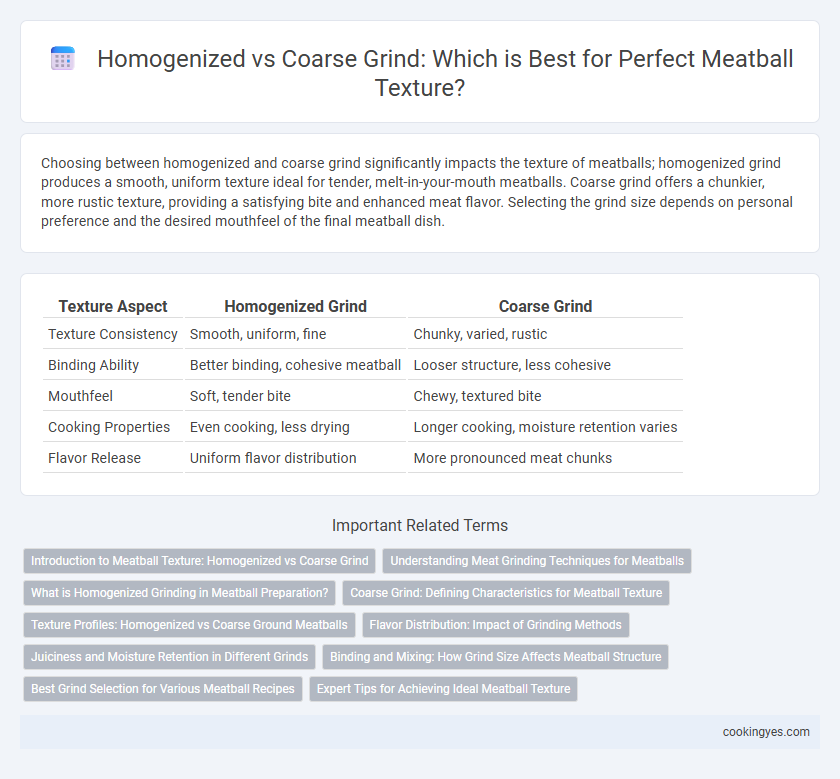Choosing between homogenized and coarse grind significantly impacts the texture of meatballs; homogenized grind produces a smooth, uniform texture ideal for tender, melt-in-your-mouth meatballs. Coarse grind offers a chunkier, more rustic texture, providing a satisfying bite and enhanced meat flavor. Selecting the grind size depends on personal preference and the desired mouthfeel of the final meatball dish.
Table of Comparison
| Texture Aspect | Homogenized Grind | Coarse Grind |
|---|---|---|
| Texture Consistency | Smooth, uniform, fine | Chunky, varied, rustic |
| Binding Ability | Better binding, cohesive meatball | Looser structure, less cohesive |
| Mouthfeel | Soft, tender bite | Chewy, textured bite |
| Cooking Properties | Even cooking, less drying | Longer cooking, moisture retention varies |
| Flavor Release | Uniform flavor distribution | More pronounced meat chunks |
Introduction to Meatball Texture: Homogenized vs Coarse Grind
Homogenized meatballs feature finely ground meat that creates a smooth and uniform texture, resulting in a tender bite and consistent flavor distribution. Coarse grind meatballs retain larger meat chunks, providing a chewier, more rustic texture with distinct meat pieces that enhance mouthfeel. The choice between homogenized and coarse grind directly impacts meatball juiciness, density, and overall sensory experience.
Understanding Meat Grinding Techniques for Meatballs
Homogenized grind produces a smooth, uniform texture ideal for tender, melt-in-the-mouth meatballs, while a coarse grind creates a chunkier, more robust bite with distinct meat pieces. Understanding these grinding techniques allows chefs to control juiciness and consistency, tailoring the meatball's mouthfeel to specific recipes. Balancing fat content and grind size optimizes flavor release and structural integrity during cooking.
What is Homogenized Grinding in Meatball Preparation?
Homogenized grinding in meatball preparation involves finely mincing the meat to create a uniform, smooth texture that blends evenly with other ingredients. This method enhances binding properties, resulting in tender, cohesive meatballs with a consistent mouthfeel. Homogenized grinding is ideal for recipes requiring delicate, soft meatballs that hold together without crumbling during cooking.
Coarse Grind: Defining Characteristics for Meatball Texture
Coarse grind for meatballs creates a distinct texture characterized by larger, uneven meat particles that retain juiciness and provide a satisfying bite. This grind allows fat to render slowly during cooking, enhancing flavor and moisture retention. The result is a meatball with a hearty, rustic texture that contrasts sharply with the smoothness of homogenized meat.
Texture Profiles: Homogenized vs Coarse Ground Meatballs
Homogenized meatballs deliver a smooth, uniform texture that ensures consistent tenderness and moisture retention, enhancing overall mouthfeel. Coarse ground meatballs provide a chunkier, more varied texture with pronounced meat fibers, offering a satisfying bite and chewier profile. Choosing between homogenized or coarse grind directly impacts the final sensory experience, with homogenized grind favoring softness and coarse grind emphasizing rustic texture.
Flavor Distribution: Impact of Grinding Methods
Homogenized grind produces a uniform texture that enhances consistent flavor distribution throughout the meatball, ensuring every bite delivers balanced seasoning. Coarse grind retains larger meat pieces, which creates varied texture and pockets of intense flavor but may result in less even seasoning spread. Choosing the appropriate grind influences not only the mouthfeel but also how flavors meld and burst during cooking, impacting overall taste experience.
Juiciness and Moisture Retention in Different Grinds
Homogenized meatball grind creates a finer texture that enhances juiciness by allowing fat and moisture to distribute evenly throughout the mixture, leading to superior moisture retention during cooking. Coarse grind offers a chunkier texture, which can result in a more robust bite but may release juices more easily, reducing overall moisture retention. Choosing homogenized grind is ideal for moist, tender meatballs, while coarse grind suits those preferring a firmer, less juicy texture.
Binding and Mixing: How Grind Size Affects Meatball Structure
Homogenized grind yields a finer texture that enhances binding by increasing the meat's protein surface area, resulting in a uniform, cohesive meatball structure. Coarse grind provides a chunkier texture that improves mixing by allowing better air incorporation and distinct meat pieces, which creates a firmer bite but may reduce overall binding. Selecting grind size directly impacts meatball texture, as finer grinds promote structural integrity while coarser grinds enhance chewiness.
Best Grind Selection for Various Meatball Recipes
Choosing between homogenized and coarse grind significantly impacts meatball texture, with homogenized grind offering a smoother, more uniform consistency ideal for delicate recipes like veal or chicken meatballs. Coarse grind provides a chunkier texture that enhances flavor and bite, making it preferable for traditional beef or pork meatballs. For the best results, select homogenized grind when seeking tenderness and cohesion, while coarse grind works well for rustic, hearty meatball dishes.
Expert Tips for Achieving Ideal Meatball Texture
For achieving the ideal meatball texture, experts recommend choosing a coarse grind for a more rustic, juicy bite that holds together well during cooking. Homogenized or finely ground meat offers a smoother, denser texture but can risk becoming mushy if overmixed or overcooked. Balancing the grind size with proper handling and ingredient ratios ensures meatballs remain tender yet firm, delivering a satisfying mouthfeel.
Homogenized vs Coarse grind for meatball texture Infographic

 cookingyes.com
cookingyes.com